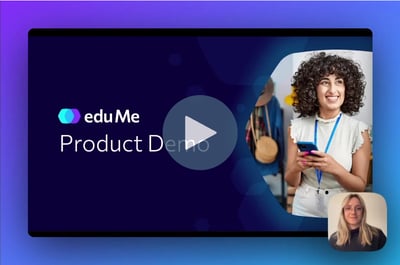Microlearning has established itself as a meaningful practice in the workforce success world. Microlearning is not just a trend, and has proven to be an effective means of delivering learning content to a workforce during their moment of need, by not overwhelming them and offering them content that is of immediate value.
The staying power of microlearning can be attributed to how effective it is. Training Industry Magazine explains, “The theory behind microlearning suggests that short, repetitive learning increases long-term comprehension rates.” Neuroscience comes into play here, because content that is repeated and used tends to remain in our long term memories.
Microlearning does not have to be used in isolation, and in fact it can be a powerful addition to pre-existing curriculums, or when used as part of an overall workforce success strategy.
Follow these six steps to successfully incorporate microlearning into your learning strategy:
1) Use microlearning to roll out content in 'bite-sized' pieces
Are you rolling out a new initiative and you’re worried about overwhelming your learners? Is your current onboarding program simply too dense for new hires to retain everything? Microlearning to the rescue! Consider breaking your new or pre-existing content into smaller segments and delivering it to staff via microlearning. Allowing them to access content on their own schedules, or releasing it in daily or weekly intervals may be more enticing to people than asking them to commit hours to long training sessions.
2) Use microlearning as reminders or reviews of content
Do you already have some training programs in place, but your learners don’t have the ability to easily review content at a later date? Microlearning courses and videos on specific topics can be great reminders of the key points or main ideas that are contained in longer training sessions. Whether your workforce need to review before an assessment, or simply want to review segments without repeating the entire curriculum, microlearning allows them to get answers in their moment of need.
3) Use microlearning to patch gaps in your curriculum
What do you do if your training program is out of date but you don’t have the time or resources to replace it entirely? Microlearning can be used to patch gaps by providing teams with updates and new information to accompany your traditional training. Whether you use eLearning, video, or other options, microlearning can be quickly created and implemented to enrich the content you’re already providing to your learners.
4) Use microlearning to limit disruptions in the workplace
Do you offer an in-person training program that staff must travel to? Do you require them to complete eLearning courses that are so time-intensive learners must schedule time to complete them? Each of these traditional offerings may be effective, but they come at the tremendous cost of disrupting your workplace and your employees’ productivity on the job. Microlearning is not meant to entirely replace existing programs, but microlearning may better accommodate learners by being less demanding of their time and by being more budget-friendly for the employer to implement. When used in conjunction with traditional offerings, microlearning can be a truly powerful tool to ensure the training curriculum meets every learners’ needs.
5) Use microlearning with learners who are "on-the-go"
Do your employees work in their home offices? Do they work out in the field away from desks and classrooms? Do they work on mobile devices? If you answered yes to any of these questions, microlearning is a format that was built with your learners in mind. When training is restricted to classrooms in an office building, or is only accessible through a labyrinth of a learning management system, employees who aren’t tied to their desks are bound to have difficulties accessing the content. However, microlearning offerings that can be easily consumed on mobile devices allow learners to obtain information whenever, and wherever they need to. Consider creating microlearning versions of your curriculum so that field employees can benefit from all the same training that their office-based colleagues participate in.
6) Use micro-assessments as reinforcement of content
Microlearning doesn’t have to be limited to the presentation of information; it can be used as assessment too!
A brief quiz with feedback allows learners to demonstrate their knowledge on a topic, as well as receive explanations of whether or not their responses were correct. Videos presented in microlearning formats can lead to assessments as well, requiring learners to showcase what they retained from the presentation.
Tools such as eduMe guide designers in creating microlearning experiences that include the presentation of content in the medium of their choice (text, photo, or video) then segue to a brief assessment that measures learners’ skills. Companies such as Ube have found this approach boosts learners’ productivity and increases engagement, while also allowing managers to access real-time records of learners’ progress and completion.
Get in touch to learn how eduMe's microlearning platform can optimize your workforce training strategy.







